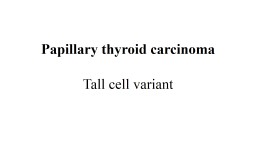

Tall cell variant 5 10 of PTCs Usually older age patients Female more than males Site of origin Thyroid Exceedingly rare at other sites ectopic thyroid tissues Sporadic in most cases ID: 1010764
Download Presentation The PPT/PDF document "Papillary thyroid carcinoma" is the property of its rightful owner. Permission is granted to download and print the materials on this web site for personal, non-commercial use only, and to display it on your personal computer provided you do not modify the materials and that you retain all copyright notices contained in the materials. By downloading content from our website, you accept the terms of this agreement.
1. Papillary thyroid carcinomaTall cell variant
2. 5 - 10% of PTCs Usually older age patients Female more than males Site of origin: Thyroid Exceedingly rare at other sites (ectopic thyroid tissues) Sporadic in most cases Risk factors: same as most other variants of PTC Ionizing radiation and pre-existing benign thyroid disease
3. The most common aggressive variant of PTCExtra-thyroidal extension and metastatic lymph nodes are commonly seen Microscopy: WHO 2017 definition: Tall cells (2 - 3x height / width cells) occupying ≥ 30% tumorWell developed PTC nuclear features If tall cell features are > 10% but < 30%, the tumor should be designated as PTC with tall cell featuresPTCs with tall cell features (≥ 10% tall cells) have worse prognosis than those without tall cells; more than 10% tall cells in a tumor should be reported in final pathology reports
4. Diagnosis Tall cell features may be recognized by cytology but a definitive diagnosis of a tall cell variant requires histologic evaluation Gold standard for the Dx: histopathologic evaluation of thyroidectomy specimens
5. Prognosis of Tall cell variant of PTCA more aggressive behavior than classic PTC independent of age, gender and tumor size, even without extra-thyroidal extension Compared to classic PTC: (often but not always)larger tumor sizemore frequent extra-thyroidal extensionmore frequent lymph node involvementa higher stage at presentation higher recurrence rateincreased tumor related mortalitymore frequent distant metastases (reported cases: pancreas, brain)accounts for ~20% of radioiodine refractory thyroid carcinomasaccounts for many non-anaplastic fatal thyroid carcinomas Risk of dedifferentiation into poorly differentiated or anaplastic thyroid carcinoma (tall cell PTC often seen as a component of these tumors)Anaplastic transformation of tall cell papillary carcinoma typically occurs in the form of a spindle cell squamoid type of anaplastic carcinoma The tall cell variant of papillary microcarcinoma (< 1 cm) is also associated with aggressive features at presentation and should be differentiated from other papillary thyroid microcarcinomas
6. PathologyGross description: Tend to be large (> 5 cm) Extra-thyroidal extension may be grossly apparent
7.
8.
9.
10.
11.
12.
13. IHC staining chractristics Positive stains Thyroid specific: Thyroglobulin, TTF1, PAX8 Cytokeratins: CK19, broad spectrum cytokeratins (AE1 / AE3) HBME, galectin3 BRAF V600E by mutation specific antibody (VE1)Negative stains Calcitonin Chromogranin Synaptophysin
14. Molecular / cytogenetics description Highest mutation density (DNA copy number alterations) of all PTC variants BRAF V600E mutation in ~80% of cases Higher frequency of TERT (telomerase reverse transcriptase) promoter mutations than in classic PTC (5 - 30% versus 10%) RAS mutations have not been identified
15. Tall cell Variant of PTCColumnar cell Variant of PTC
16. Differential diagnoses Other papillary thyroid carcinoma variants:Classic variant with tall cell features: < 30% of tall cell component Columnar cell variant: Nuclear stratification, rare nuclear pseudoinclusions, absence of eosinophilic cytoplasm and distinct cell borders Often CDX2 positive Warthin-like variant: Dense lymphocytic infiltration within vascular cores of stroma, rarely infiltrative Oncocytic variant: No or only rare tall cells, lack of distinct cell borders, prominent nucleoli Breast tall cell carcinoma with reversed polarity (very rare): Focal positivity for GATA3, GCDFP-15 and mammaglobin TTF1, thyroglobulin and BRAF V600E consistently negative